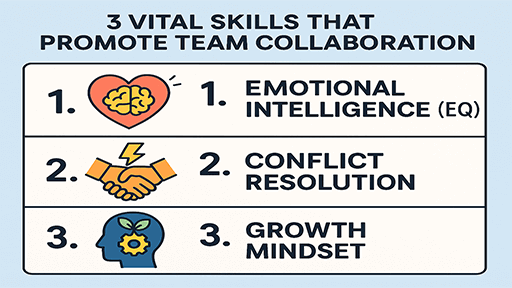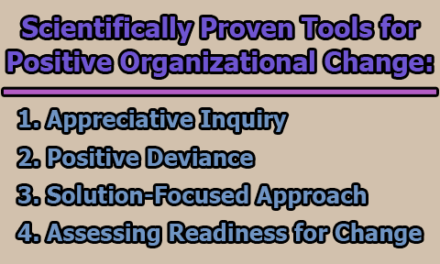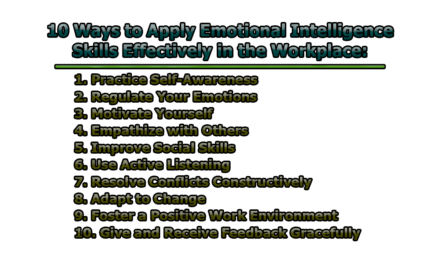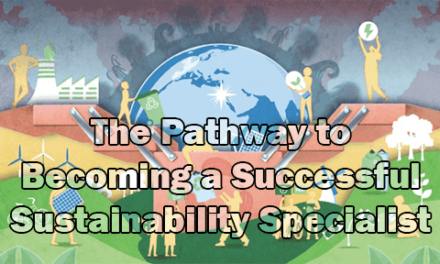3 Vital Skills That Promote Team Collaboration:
In today’s dynamic organizational landscape, effective team collaboration is not just an advantage — it’s a necessity. Many organizations develop extensive strategies to encourage teamwork and cross-functional cooperation. However, even the most carefully crafted collaborative frameworks can falter if leaders do not possess the essential skills to guide, motivate, and support their teams. To foster a thriving environment where people work together productively, leaders must cultivate key competencies that enable them to manage people, resolve disagreements, and create a culture of continuous learning and adaptability. Below are the 3 vital skills that promote team collaboration.
1. Emotional Intelligence (EQ):
Emotional intelligence, or EQ, is widely recognized as one of the most important leadership skills for promoting effective team collaboration. As defined by Goleman (1998), EQ is the ability to perceive, understand, manage, and influence emotions — both your own and those of others. Unlike technical skills, emotional intelligence is about people skills: how leaders connect with, motivate, and support their teams in day-to-day interactions.
Leaders who demonstrate strong EQ tend to excel in self-awareness, which is the foundation of all other emotional competencies. Self-aware leaders know their strengths, weaknesses, and emotional triggers. For instance, they might recognize that they become defensive when their ideas are challenged — and instead of reacting impulsively, they pause, listen, and respond thoughtfully. This self-control prevents unnecessary conflicts and sets a tone of mutual respect within the team.
Equally important is self-regulation. Leaders with high EQ can manage disruptive emotions such as anger, frustration, or anxiety. Imagine a situation where a project suddenly faces unexpected obstacles or client feedback is harsh. A leader with strong EQ remains calm, refrains from blaming team members, and focuses on solutions. This calmness reassures the team, helps reduce stress, and encourages everyone to stay engaged in problem-solving rather than panic.
Empathy is another critical dimension of EQ. An empathetic leader strives to understand what team members are experiencing — whether it’s stress from workload, personal challenges, or feeling unheard. They take time to listen actively, ask clarifying questions, and acknowledge people’s feelings without judgment. For example, if a team member appears withdrawn during meetings, an empathetic leader might privately check in, showing care and support. This small action can dramatically boost trust and loyalty.
Social skills, a key part of EQ, also play a vital role. Leaders who master social skills know how to build strong relationships, manage group dynamics, and resolve tension diplomatically. They are skilled communicators who can deliver feedback constructively, facilitate open discussions, and encourage diverse viewpoints without letting disagreements derail progress. For instance, if two team members disagree on an approach, an emotionally intelligent leader creates space for both sides to share perspectives, mediates calmly, and guides the group toward consensus.
Moreover, emotionally intelligent leaders cultivate psychological safety, which is the belief that team members can speak up, take risks, and share ideas without fear of embarrassment or retaliation. This safety is essential for collaboration because it empowers people to contribute fully, admit mistakes, and ask for help when needed. Over time, this builds a culture where innovation thrives and problems are addressed proactively.
In practice, leaders with high EQ also model empathy and emotional balance for the entire team. Their behavior sets the standard — when team members see their leader handling conflict gracefully, managing stress positively, and treating everyone with respect, they’re more likely to mirror these behaviors themselves.
Organizations that prioritize EQ in leadership roles often see benefits like improved team morale, reduced turnover, smoother conflict resolution, and stronger working relationships. In a collaborative setting, where people constantly interact and rely on each other’s contributions, the leader’s EQ can be the difference between a group that functions like a cohesive unit and one that struggles with misunderstandings and low trust.
In brief, emotional intelligence is not an optional soft skill — it’s a foundational leadership capability that holds collaborative teams together. By building self-awareness, practicing empathy, regulating emotions, and nurturing positive relationships, leaders create an environment where collaboration is not only possible but genuinely rewarding for everyone involved.
2. Conflict Resolution:
Conflict is an unavoidable part of working with people — whenever individuals come together to share ideas, solve problems, or make decisions, disagreements can naturally emerge. While conflict often carries a negative connotation, it does not have to be destructive. When handled well, conflict can spark creativity, surface valuable perspectives, and strengthen team cohesion. For leaders, mastering the skill of conflict resolution is therefore essential to keeping collaboration healthy and productive (Mumford et al., 2000).
Leaders who are effective conflict managers first recognize that not all conflict is the same. Some conflicts are task-related — for example, differing opinions on how to allocate resources or design a project. Others are relationship-based, rooted in misunderstandings, personality clashes, or poor communication. Understanding the root cause helps leaders choose the right approach.
A leader skilled in conflict resolution knows how to de-escalate tensions before they damage working relationships. For instance, if two team members begin to argue during a meeting, an observant leader might step in calmly, acknowledge both perspectives, and suggest taking the discussion offline to find a constructive solution. This prevents the conflict from derailing the meeting or creating an uncomfortable environment for others.
One important aspect of conflict resolution is active listening. Leaders should listen to all sides without jumping to conclusions or taking sides too quickly. By allowing each person to explain their concerns fully, a leader shows respect and creates a sense of fairness. This alone can often reduce defensiveness and open the door to compromise.
A good conflict resolver also helps find common ground. They reframe problems as shared challenges rather than personal battles. For example, instead of letting two team members argue over whose idea is better, a leader might say, “It seems like both ideas have strengths — let’s see how we can integrate the best parts of each.” This shifts the conversation from winning or losing to finding a mutually beneficial outcome.
Another key technique is encouraging consensus or compromise. Consensus means working toward a solution everyone actively supports, while compromise accepts that everyone may need to give up something to reach an agreement. A leader might facilitate a brainstorming session where the team generates multiple options and weighs the pros and cons together. This inclusive approach empowers the team to own the solution and builds trust that conflicts will be handled fairly.
In addition to managing conflicts when they occur, strong leaders also prevent unnecessary conflicts through clear communication and well-defined roles. They set expectations early, make sure responsibilities are understood, and foster an open culture where people feel comfortable raising issues before they escalate.
An example of this could be a leader who notices a recurring clash between two departments over project deadlines. Rather than allowing frustration to build, they might organize regular check-ins, clarify timelines, and create a shared calendar to improve transparency and accountability.
Importantly, conflict resolution is not about avoiding difficult conversations — it’s about handling them constructively. Leaders who shy away from addressing conflicts often allow resentment and confusion to fester, which can fracture teams and stall collaboration. On the other hand, leaders who face conflicts head-on and resolve them respectfully help their teams grow stronger and more resilient.
In collaborative environments, where diverse perspectives and tight deadlines intersect, conflict resolution transforms potential friction into opportunities for learning, problem-solving, and building stronger relationships. By guiding teams through disagreements with fairness, patience, and empathy, leaders ensure that conflicts become stepping stones, not stumbling blocks, on the path to shared success.
3. Growth Mindset:
Another vital skill that supports successful team collaboration is the ability to cultivate and demonstrate a growth mindset. The term, popularized by Dweck (2006), describes the belief that abilities, skills, and intelligence can be developed through dedication, effort, and learning. In contrast, a fixed mindset assumes that talents and abilities are static — you either have them or you don’t. For leaders, the difference between these two outlooks can make or break how a team faces challenges together.
A leader with a growth mindset not only applies this attitude to their own development but actively encourages it in others. They frame mistakes not as failures but as opportunities for improvement. For example, if a team project does not meet client expectations, a growth-minded leader avoids assigning blame and instead leads a constructive debrief: “What did we learn? What can we do differently next time?” This attitude builds a safe learning environment where people are not afraid to try new approaches or share bold ideas.
Promoting a growth mindset also helps teams tackle obstacles more effectively. When employees believe that skills can be developed, they are more likely to persist through setbacks and experiment with alternative solutions. For instance, a team working on a complex software rollout may face repeated technical glitches. A leader who models a growth mindset will motivate the team to see each failed test as valuable data that brings them closer to success — rather than a reason to give up or point fingers.
Leaders with a growth mindset invest in learning — for themselves and their teams. They encourage continuous skill development through training, mentoring, and collaborative problem-solving. This creates an environment where people feel supported to stretch beyond their comfort zones, take initiative, and bring fresh ideas to the table. When team members see that improvement is valued more than perfection, they are more likely to share innovative suggestions and experiment without fear of harsh judgment.
A growth mindset also fosters psychological resilience within teams. In rapidly changing work environments, setbacks and ambiguity are inevitable. Leaders who help their teams stay optimistic and adaptable transform these challenges into fuel for growth rather than sources of stress. For example, when a client suddenly changes project requirements, a growth-minded leader reframes it as a chance to learn new skills or discover more efficient processes — helping the team maintain momentum and motivation.
In collaborative settings, this mindset is contagious. When a leader consistently demonstrates curiosity, openness to feedback, and a willingness to learn from others — regardless of rank or experience — team members often mirror this behavior. Over time, it builds a team culture where learning from one another is normal and everyone contributes to collective improvement.
A practical illustration of a growth mindset in action might be a leader encouraging cross-functional collaboration. Instead of restricting employees to narrow roles, they create opportunities for people to work on projects outside their usual scope, trusting that skills can be picked up through practice. This not only strengthens team capability but also increases engagement, as employees feel their potential is recognized and nurtured.
Finally, a growth mindset helps leaders approach their own leadership development as an ongoing journey. They actively seek feedback, learn from peers, and adapt their style as needed. By showing humility and a willingness to evolve, they set a powerful example that learning never stops — no matter how experienced or senior someone is.
In short, fostering a growth mindset is a key ingredient in enabling collaboration that is innovative, adaptable, and resilient. Leaders who champion this belief help teams see that challenges are not dead ends but stepping stones to improvement. As Dweck (2006) emphasizes, when people believe they can grow, they become more willing to try, fail, learn, and succeed — together.
It is apparent that true leadership in collaborative environments is not about controlling every aspect of teamwork; it’s about enabling it. Emotional intelligence, conflict resolution skills, and a growth mindset are not optional — they are essential. Leaders who build these skills lay the foundation for teams to thrive, innovate, and achieve common goals together. In doing so, they help create a culture where collaboration is not just a strategy but a meaningful, rewarding way of working. By investing in these vital skills, organizations can unlock the full potential of their teams and sustain success in an ever-evolving world.
Frequently Asked Questions (FAQs):
Why is emotional intelligence more important than technical skills for team leaders?
While technical skills are important for understanding tasks and industry requirements, emotional intelligence (EQ) determines how a leader manages people, relationships, and day-to-day interactions. Teams work best in environments of trust, empathy, and open communication — all of which depend on EQ. A technically skilled leader without EQ may struggle to motivate the team, resolve tensions, or create psychological safety, which can undermine collaboration regardless of how good the technical plan is.
How can leaders develop better conflict resolution skills?
Conflict resolution skills can be strengthened through practice and training. Leaders can start by learning to listen actively, staying calm under pressure, and seeking to understand different perspectives without judgment. Role-playing difficult conversations, attending workshops on negotiation, and studying real conflict scenarios in teams can also help. Above all, leaders should cultivate the habit of addressing small issues early before they grow into larger conflicts.
What are some practical ways to encourage a growth mindset in a team?
Leaders can foster a growth mindset by praising effort and learning instead of only outcomes, encouraging experimentation and calculated risk-taking, and normalizing mistakes as part of the learning process. Providing training opportunities, giving constructive feedback, and modeling curiosity themselves are also effective. Simple actions like asking, “What did we learn from this?” after a project reinforces the idea that progress is more important than perfection.
What happens if a leader lacks these three skills?
Without emotional intelligence, conflict resolution skills, and a growth mindset, teamwork often suffers. Team members may feel misunderstood, fear making mistakes, avoid sharing ideas, or withdraw during disagreements. This can lead to low morale, frequent misunderstandings, unresolved conflicts, and missed opportunities for innovation — ultimately harming productivity and trust within the team.
Are these skills relevant only for managers, or do team members need them too?
While leaders have the greatest influence, all team members benefit from developing these skills. A team where everyone practices empathy, handles disagreements maturely, and sees mistakes as learning opportunities is naturally more collaborative and resilient. Leaders should encourage and model these skills so that they spread throughout the group.
Can emotional intelligence and growth mindset really be learned, or are they innate traits?
Research shows that both emotional intelligence and a growth mindset can be developed over time with intentional effort. People can become more self-aware, better at managing emotions, more empathetic, and more open to learning through coaching, practice, feedback, and reflection. The key is consistent practice and a willingness to improve.
How do these three skills work together to support collaboration?
Emotional intelligence helps leaders understand and connect with people. Conflict resolution skills ensure that disagreements don’t derail teamwork but instead strengthen understanding. A growth mindset keeps the team focused on learning and improving rather than fearing failure. Together, these skills create an environment where collaboration feels safe, supportive, and productive.
References:
- Dweck, C. S. (2006). Mindset: The new psychology of success. Random House.
- Goleman, D. (1998). Working with emotional intelligence. Bantam.
- Mumford, M. D., Zaccaro, S. J., Harding, F. D., Jacobs, T. O., & Fleishman, E. A. (2000). Leadership skills for a changing world: Solving complex social problems. The Leadership Quarterly, 11(1), 11–35. https://doi.org/10.1016/S1048-9843(99)00041-7

Library Lecturer at Nurul Amin Degree College










